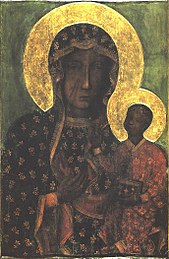
Back مادونا السوداء Arabic مادونا السوداء ARZ Черна Мадона Bulgarian Verge negra Catalan Černá Madona Czech Den sorte madonna Danish Schwarze Madonna German Nigra Madono Esperanto Vírgenes negras Spanish Ama Birjina beltzak Basque




The term Black Madonna or Black Virgin tends to refer to statues or paintings in Western Christendom of the Blessed Virgin Mary and the Infant Jesus, where both figures are depicted with dark skin.[1] Examples of the Black Madonna can be found both in Catholic and Orthodox countries.
The paintings are usually icons, which are Byzantine in origin or style, some of which were produced in 13th or 14th-century Italy. Other examples from the Middle East, Caucasus or Africa, mainly Egypt and Ethiopia, are even older.[citation needed] Statues are often made of wood but are occasionally made of stone, painted, and up to 75 cm (30 in) tall. They fall into two main groups: free-standing upright figures or seated figures on a throne. About 400–500 Black Madonnas have been recorded in Europe, with the number related to how they are classified. There are at least 180 Vierges Noires in Southern France alone. There are hundreds of copies made since the medieval era. Some are displayed in museums, but most are in churches or shrines and are venerated by believers. Some are associated with miracles and attract substantial numbers of pilgrims.
Black Madonnas come in different forms. Speculations behind the basis of the dark hue of each individual icon or statue vary greatly and some have been controversial. Explanations range from Madonnas made from dark wood, or Madonnas that have turned darker over time, due to factors such as aging or candle smoke, to a study by Jungian scholar Ean Begg into the potential pagan origins of the cult of the black Madonna and child.[2] Another suggestion is that dark-skinned representations of pre-Christian deities were re-envisioned as the Madonna and child.[3]
- ^ "Black Madonnas: Origin, History, Controversy". udayton.edu. The Jungian scholar, San Begg published a study of Black Virgins and their possible pagan origins.
- ^ Begg, Ean (2017). The Cult of the Black Virgin. Chiron Publications. ISBN 978-1630514419.
- ^ Moss, Leonard W.; Cappannari, Stephen C. (1953). "The Black Madonna: An Example of Culture Borrowing". The Scientific Monthly. 76 (6): 319–324. Bibcode:1953SciMo..76..319M. ISSN 0096-3771. JSTOR 20482.
© MMXXIII Rich X Search. We shall prevail. All rights reserved. Rich X Search